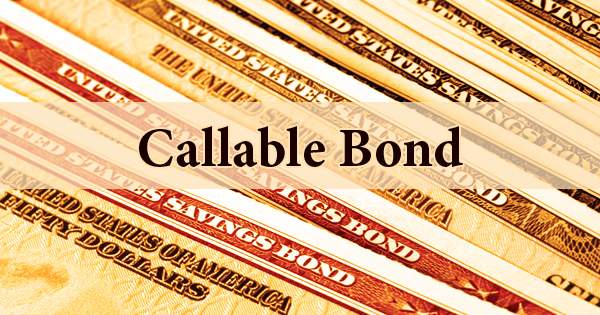What is a Callable Bond?
- Posted on November 02, 2022
- Financial Terms
- By Glory

A bond that can be redeemed by the issuer before the
specified maturity date is reached is referred to as a callable bond, sometimes
called a redeemable bond. A callable bond enables the issuing corporation
to settle its debt before its due date. As market interest rates decline, a
company may decide to call their bond, enabling them to re-borrow money at a
more favorable rate.
Callable
Bonds Explained
A bond containing an embedded call option is referred
to as a callable bond.
Bonds can be issued by corporations to finance growth
or to settle other debt. If they anticipate a decline in market interest rates,
they can choose to make the bond callable, which would enable them to redeem it
early and obtain additional funding at a reduced interest rate. The parameters
of when the corporation may recall will be outlined in the bond's sale.
In a callable bond, the issuer has the right to stop
making interest payments and returning the investor's principal before the
bond's maturity.
A callable, redeemable bond is often called at a price
that is somewhat higher than the debt's par value.
The call option on these bonds often has some limitations.
For instance, the bonds might not be redeemable during a predetermined initial
period of their existence. Additionally, certain bonds only permit bond
redemption in the event of specific unusual circumstances.
Callable bonds therefore offer a more appealing
interest rate or coupon rate thanks to their callability.
If interest rates are anticipated to decline, callable
bonds can be advantageous to the bond issuers. The issuers may choose to redeem
their bonds in this situation and issue new bonds with reduced coupon rates.
Conversely, callable bonds expose investors to greater
risk. The investors would forfeit most future interest payments if the bonds
were redeemed. The speculative feature of the bonds usually entails a premium
to make up for the added risk to investors.
Example
of Callable Bond
Consider a scenario of XYZ Corp. which issued bonds
with a face value of $150 and a coupon rate of 7.5%, on a 5% current interest
rate. The bond's maturity period is 10 years.
If the corporation decides to redeem the bonds from
investors after the first half of the maturity period (five years in this
case), it issue the bonds with an embedded call option.
Afterwards, if interest rates decreases XYZ
Corp. can call back the bonds and replace them with new bonds that have
a significantly a lower coupon rate. In this case, investors receive the
face value of the bond but forfeit any future coupon payments.
The embedded call option will terminate without being
exercised if the interest rate rises or stays the same because there will be no
motive for the corporation to redeem the bonds.
By using callable bonds, a corporation can reduce
interest costs and avoid long-term financial issues in the event that economic
or financial conditions deteriorate. That is, a corporation may issue new
debt at a lower interest rate than the initial callable bond if market interest
rates drop after the bond is floated.
By exercising the call feature on the earlier callable
bond, the corporation utilizes the revenues from the lower-rate issue to
settle the debt. As a result, the business repaid its debt by substituting
newly-issued debt with a lower interest rate for the callable bonds that had a
higher yield.
Perks
of Callable Bonds
Investors receive a higher coupon or interest rate
from callable bonds than from non-callable bonds. The company may call the note
if the market interest rate drops below the rate being provided to the
bondholders. The debt could then be refinanced at a cheaper interest rate. In
most cases, using this flexibility is better for the company than taking a loan
from the bank.
But not all aspects of a callable bond are
advantageous. When interest rates decrease, the issuer will often call the
bond. Due to this calling, the investor is at risk of having their investment
replaced at a rate that will not generate the same amount of revenue. On the
other hand, if market rates increase and the investor's funds.
In contrast, if an investor's money is invested in a
product that pays a lesser return as market rates rise, they risk falling
behind. Ultimately, companies need to raise their coupons to appeal
to investors.
Types
of Callable Bonds
Bonds that are callable come in a wide variety.
Redeeming bonds voluntarily allows the issuer to do so in accordance with the
conditions set forth at the time of issuance. Not all bonds, meanwhile, are
callable. Generally speaking, Treasury bonds and Treasury notes cannot be
called, but there are a few exceptions.
Callable bonds include several municipal bonds and
some corporate bonds. A call feature on a municipal bond can be used after a
predetermined time, such ten years.
Sinking
fund redemption necessitates that the
issuer follow a predetermined timeline when redeeming all or a portion of its
obligation. The Company shall pay Bondholders a part of the Bond on certain
dates. A sinking fund enables the business to gradually save money and prevent
a huge payment at maturity.
Extraordinary
redemption allows the issuer to call its
bonds prematurely in certain circumstances, such as when the financed endeavor
it is backing is harmed or destroyed.
Call
protection is the period during which the bond
cannot be called. A bond's callability and the specifics of the call option,
such as the window of time during which the bond may be called, must be made
clear by the issuer.


Be the first to comment!
You must login to comment